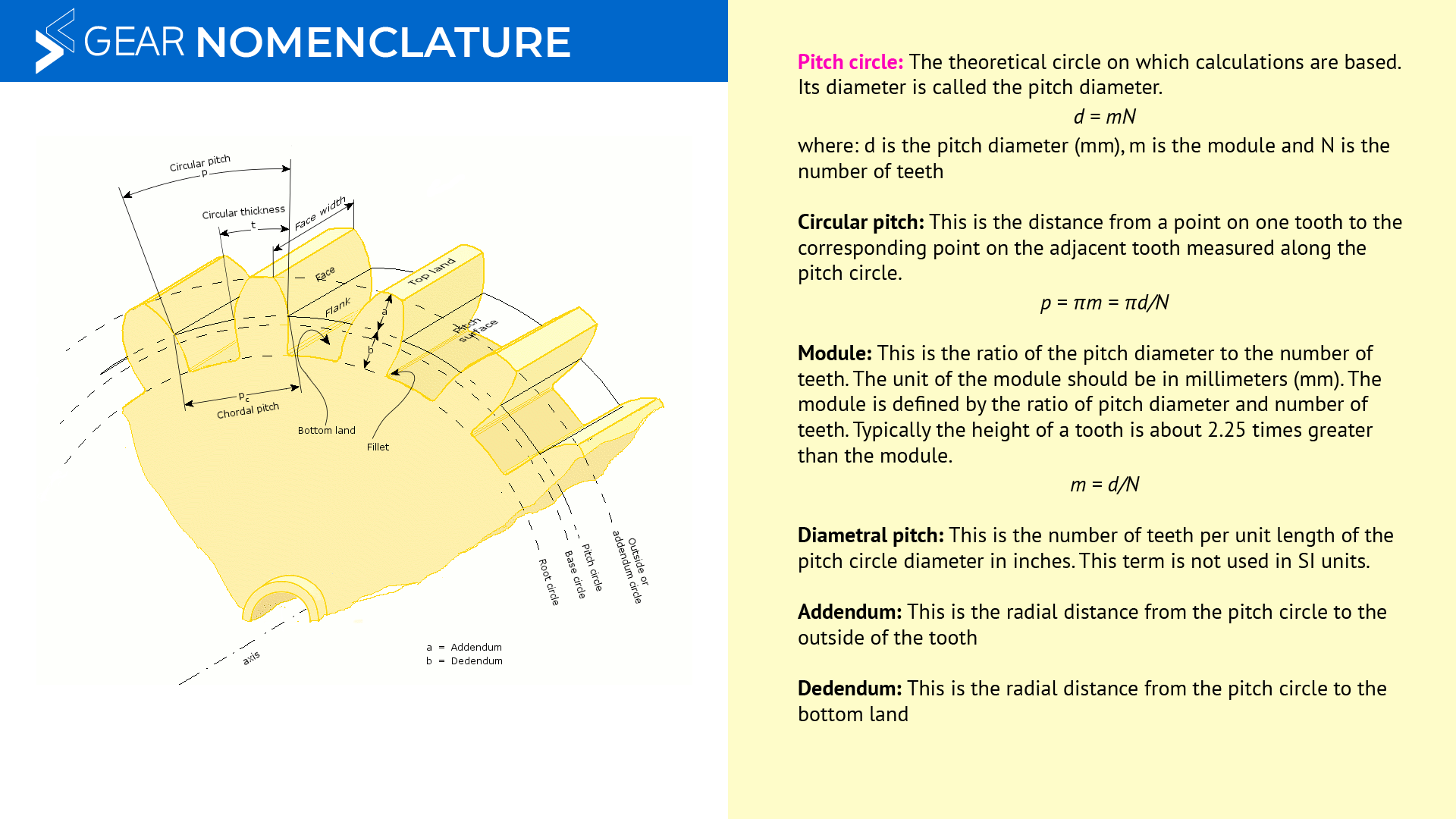
Gear Terminology
- Pitch circle. It is an imaginary circle which by pure rolling action, would give the same motion as the actual gear.
- Pitch circle diameter. It is the diameter of the pitch circle. The size of the gear is usually specified by the pitch circle diameter. It is also known as pitch diameter.
- Pitch point. It is a common point of contact between two pitch circles.
- Pitch surface. It is the surface of the rolling discs which the meshing gears have replaced at the pitch circle.
- Pressure angle or angle of obliquity. It is the angle between the common normal to two gear teeth at the point of contact and the common tangent at the pitch point. It is usually denoted by φ.The standard pressure angles are 14.5° and 20°.
- Addendum. It is the radial distance of a tooth from the pitch circle to the top of the tooth.
- Dedendum. It is the radial distance of a tooth from the pitch circle to the bottom of the tooth.
- Addendum circle. It is the circle drawn through the top of the teeth and is concentric with the pitch circle.
- Dedendum circle. It is the circle drawn through the bottom of the teeth. It is also called root circle.
Note: Root circle diameter = Pitch circle diameter × cos φ, where φ is the pressure angle.
- Circular pitch. It is the distance measured on the circumference of the pitch circle from a point of one tooth to the corresponding point on the next tooth. It is usually denoted by pc.
Mathematically, circular pitch is denoted by
where D = Diameter of the pitch circle and T = Number of teeth on the wheel.
A little consideration will show that the two gears will mesh together correctly, if the two wheels have the same circular pitch.
Note: If D1 and D2 are the diameters of the two meshing gears having the teeth T1 and T2 respectively, then for them to mesh correctly,
- Diametral pitch. It is the ratio of number of teeth to the pitch circle diameter in millimetres.
It is denoted by pd.
Mathematically, diametral pitch is represented aswhere T = Number of teeth and D = Pitch circle diameter.
- Module. It is the ratio of the pitch circle diameter in millimetres to the number of teeth. It is usually denoted by m. Mathematically,
- Clearance. It is the radial distance from the top of the tooth to the bottom of the tooth, in a meshing gear. A circle passing through the top of the meshing gear is known as clearance circle.
- Total depth. It is the radial distance between the addendum and the dedendum circles of a gear. It is equal to the sum of the addendum and dedendum.
- Working depth. It is the radial distance from the addendum circle to the clearance circle.It is equal to the sum of the addendum of the two meshing gears.
- Tooth thickness. It is the width of the tooth measured along the pitch circle.
- Tooth space. It is the width of space between the two adjacent teeth measured along the pitch circle.
- Backlash. It is the difference between the tooth space and the tooth thickness, as measured along the pitch circle. Theoretically, the backlash should be zero, but in actual practice some backlash must be allowed to prevent jamming of the teeth due to tooth errors and thermal expansion.
- Face of tooth. It is the surface of the gear tooth above the pitch surface.
- Flank of tooth. It is the surface of the gear tooth below the pitch surface.
- Top land. It is the surface of the top of the tooth.
- Face width. It is the width of the gear tooth measured parallel to its axis.
- Profile. It is the curve formed by the face and flank of the tooth.
- Fillet radius. It is the radius that connects the root circle to the profile of the tooth.
- Path of contact. It is the path traced by the point of contact of two teeth from the beginning to the end of engagement.
References:
Wikimedia Commons contributors, “File:Gear words.png,” Wikimedia Commons, the free media repository,https://commons.wikimedia.org/w/index.php?title=File:Gear_words.png&oldid=150134343 (accessed April 1, 2018).





